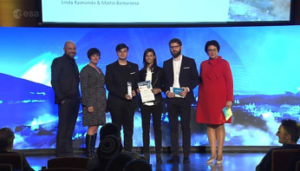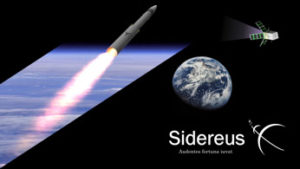We are now witnessing an extraordinary historical moment for space exploration and Space Economies. The reality of the space economy is that of a very dynamic market that in one to two years will achieve extraordinary results, in an economy that can be worth billions in less than a decade (prospects are for $63.2 bln by 2023). In this context the idea behind Sidereus Space Dynamics (Sidereus for short) is to develop low-cost transportation systems (IoBs, Interorbital Buses) for small satellites (small sats) to reduce the costs of reaching deep space.

Awarding ceremony in Bilbao during ESA Space for Inspiration.
The name comes from the astronomical treatise of Galileo Galilei of 1610, the Sidereus Nuncius, which literally means “heavenly messenger“. The current market of small satellites is today the engine of space economies, driven by innovations that have involved several markets over the past decade. From the reduction in the costs of launching, to electronic minia-turization (i.e. CCD was developed only in 1999) and in the costs of constructing composites (i.e. carbon fiber/lithium-aluminum alloy, 3D printing) it is leading to the gradual replacement of large satellites in favor of small, cheap, numerous small sats, with the same functionalities. Transport costs, although reduced for the low orbit, remain very consistent. Moreover high orbits like the geostationary orbit (GEO, fundamental for communications and Earth observation) and escape orbits of (towards Moon, Lagrange points and beyond) remain incredibly expensive to reach. The only companies to operate these trajectories are SpaceX, United Launch Alliance, Ariane. Their main focus, however, are large satellites, not small sats, which, in addition to rare launch possibilities, must pay $150k/kg for the GEO orbit and $1.2M/kg for the Moon. When compared to the low orbit (LEO), whose costs are $10k/kg, it is clear that a transport system to deep space is needed. If it were possible to reduce the costs of access to the high orbit, it could be possible to play a fundamental role in transport, creating new markets in addition to network relays, communications, earth observations, IoT and M2M communications, private internets and crypto security. For example, two large markets for the next decade are sample return and lunar mining. In order to do this, one of Sidereus’ proposals is to build cubesats capable of transporting small satellites to GEO or beyond, from the low orbit where they are left by larger launchers, within two years.

Despite the ambitiou-sness of the project, the feasibility is far from remote. Cubesats do not require particular electronics, they can be designed and launched in less than a year, as demonstrated by the launch in 2013 of one realized by an elemen-tary school.
And then, with the recognitions and awards of the European Space Agency and the chamber of commerce of Huntsville, Alabama, the help from the US I2C incubator, an office space at the University of Alabama Huntsville and the enthusiasm for the project, from 27 January onwards this adventure will take hold, from the search for investors on which we are working now, to the practical realization of the project.
Here then is when the motto we wanted for this new adventure comes in handy:
«Audentes fortuna iuvat» (Latin: “Luck helps the brave”).
For further information, visit the website created in record time: www.sidereus.space
Or you can write to info@sidereus.space.

THE MAIN GALAXY IS CONQUERING THE SPACE!
Mattia Barbarossa is a really extraordinary guy with extraordinary ideas.
During the 19th December meeting, MAIN Investment Committee enthusiastically decided to support his idea of being the youngest aerospace entrepreneur in the world.
On January 27th, in fact, Mattia will turn 18 and on that day Sidereus Space Dynamics,
a joint venture MAIN – Mattia Barbarossa, will be set up with the aim of being active in the Space Economy sector with the Sidereus project. We will see what happens!



